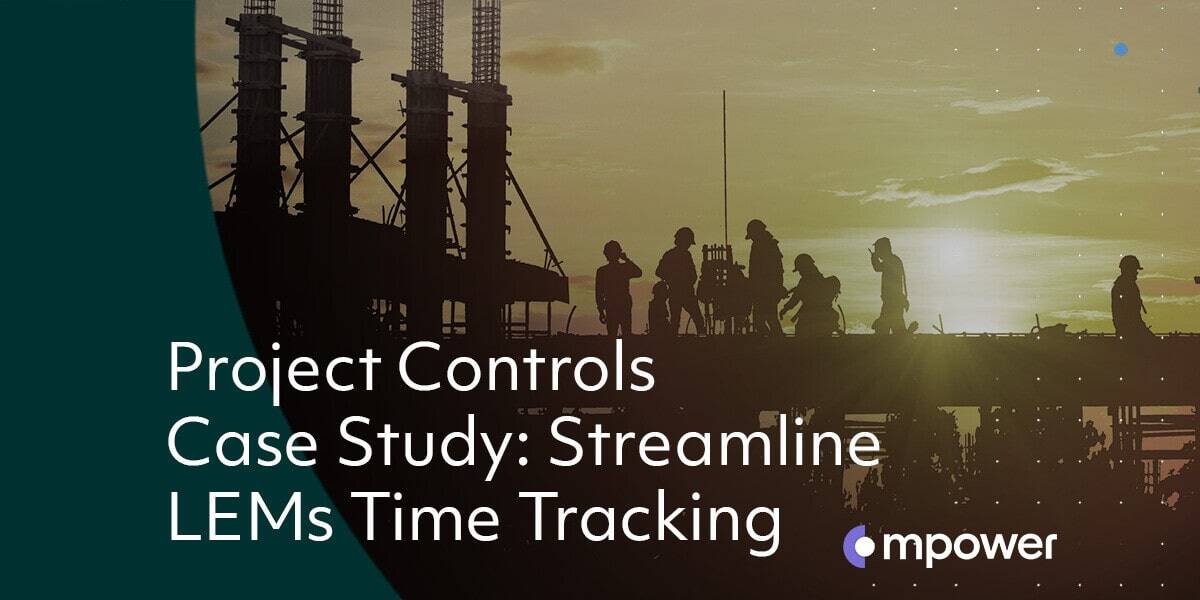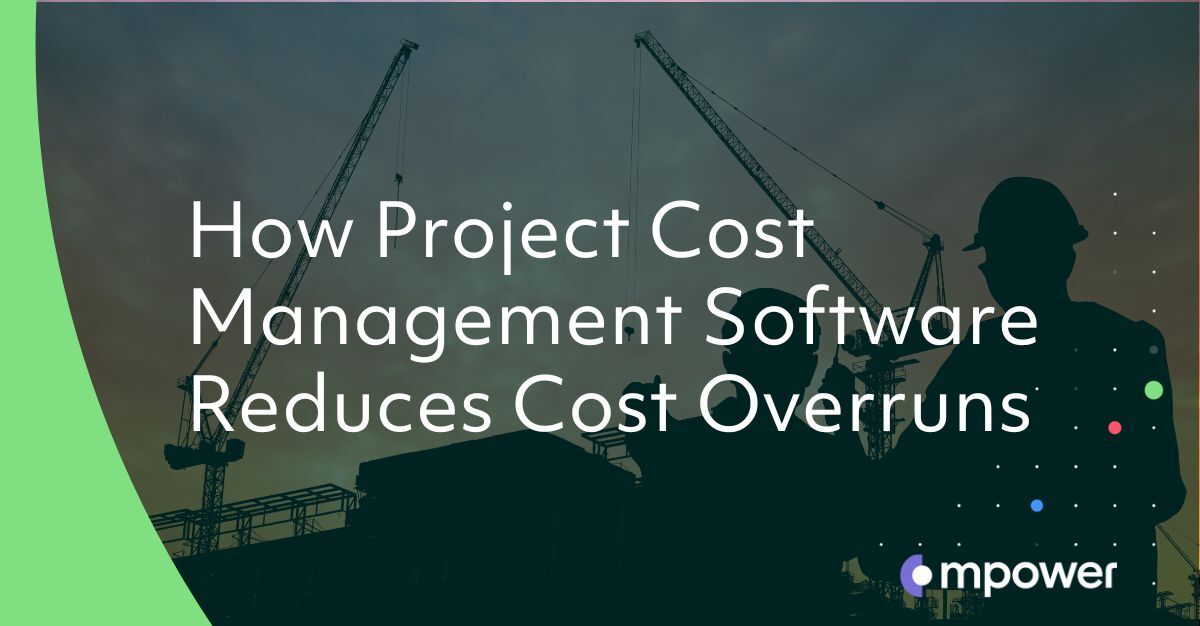
How to Select the Right Project Controls Software for Construction
In an industry where project management is increasingly complex and margins are tight, choosing the right project controls software to manage construction costs, risk, and resources is essential to project success. In this post, I'll equip you with everything you need to know to help you find the best solution for your construction projects and how Mpower Project Controls and Cost Management Software is designed specifically for the construction sector to help project teams stay on top of budgets and timelines with data-driven decision-making.
Contents
- What is Project Controls Software?
- Why Do Major Construction Projects Need Project Controls Software?
- What Construction Projects Require in Project Controls Software
- Progress Measurement
- Estimating and Budget Control
- Controlled Change Management
- Risk and Contingency Visibility
- Claims and Invoicing
- Procurement Cost Control
- System Integration and Data Consistency
- Summary
- FAQs
What is Project Controls Software?
Project controls software is a digital solution designed to plan, monitor, and regulate all aspects of project execution, especially around cost, schedule, and scope. In construction, it enables project controllers and stakeholders to coordinate timelines, manage budgets, handle risks and changes, and create performance reports. Project controls solutions like Mpower Project Controls & Cost Management Software offer integrated features that can be tailored to construction professionals, allowing you to manage multiple projects, contractors, and financial models all from one system.
Why Do Major Construction Projects Need Project Controls Software?
- Cost Management: Software built around a proper Cost Breakdown Structure helps pinpoint budget issues early by comparing planned vs. actual spending. Different to cost accounting, it's about trend spotting and productivity tracking (especially labour hours) to keep costs in check.
- Schedule Planning: A well-defined Control Schedule sets the blueprint for construction timelines. Project controls software enables realistic updates and short-term plans that align with overall goals, avoiding the chaos of ad-hoc field planning and endless rescheduling.
- Materials Tracking: When materials aren't where they need to be, progress stalls. Integrating procurement data into your scheduling system ensures materials arrive on time and in the right place, keeping your crews moving and your plans intact.
What Construction Projects Require in Project Controls Software
Based on the most common construction industry challenges identified by our experts, here are seven essential features to look for when deciding on a project controls solution:
1. Progress Measurement
Inconsistent work definitions, disconnected systems and unreliable data flows can make measuring construction progress more difficult than it needs to be. These issues can snowball into inaccurate forecasts, budget overruns, and missed schedule targets.
Mpower's Solution
- Flexible Progress Definitions: Mpower's project planning and estimating tools allow teams to define scope in granular detail using job cards, work orders, engineering Cost, Time, and Resources (CTRs), and Advanced Work Packaging (AWP). By integrating norms and templates with actual labour hours, it supports ongoing refinement through a closed feedback loop, ensuring continuous improvement and precision in progress tracking.
- Scheduling-Driven Productivity Insights: Through earned value tracking, schedule compliance, and productivity monitoring, Mpower ties progress measurement directly to planning outputs and resource performance. Its integration with cost, labour, and revenue data across timesheets, accruals, and invoicing, supports accurate forecasting and proactive control throughout construction phases.
2. Estimating and Budget Control
Early estimates often miss the mark due to restricted designs and limited data. Pre-FEED (Front-End Engineering Design) and FEED phases rarely provide enough detail to accurately forecast labour, materials, and productivity. Misaligned budgets between engineering, procurement, and construction phases often mean that EPC workflows lack continuity, leading to fragmented cost control.
Mpower's Solution
- End-to-End Cost Estimation and Budget Definition: Provides standardised estimating templates and norms to drive consistency in labour, material, equipment, and subcontractor pricing during pre-construction and tendering. A closed-loop feedback system then pulls real-world performance data from time tracking and productivity modules to refine future estimates. Integrated top-down and bottom-up budgeting supports project-specific inputs and constraints, aligning scope definitions and contract planning for early-stage budget accuracy.
- Performance-Linked Cost Monitoring and Forecasting: Construction budgets are dynamically linked to field progress and forecast data, enabling real-time variance analysis and early identification of budget drift. Mpower's integration with ERP and scheduling platforms such as Primavera P6—plus its own Gantt tools—ensures visibility into cost consumption across work packages. Earned Value Management (EVM) further supports financial predictability by tracking crew productivity and schedule adherence, keeping targets on track
Related Content:
3. Controlled Change Management
Scope changes and their cost implications are frequent in construction projects, but often poorly documented thanks to design changes and a lack of structured change control processes. This inevitably leads to budget overruns and disputes over cost recovery.
Mpower's Solution
- Change Order Management: Tracks original contract values, approved modifications, and forecasted adjustments for scope changes throughout the construction lifecycle; each change is backed by a full audit trail, enabling contractors, clients, and stakeholders to monitor the financial and scheduling impact of change orders with full transparency.
- Variation Control: Supports structured workflows designed for managing variations in construction projects—these workflows guide review and approval processes across disciplines and teams, helping project managers maintain accountability, eliminate confusion, and ensure that changes are properly documented and authorised before implementation.
4. Risk and Contingency Visibility
Inadequate risk identification and over/under-estimation of contingencies make it difficult to balance risk exposure with cost competitiveness. Risks are either underestimated or padded excessively, with weather, labour shortages, and regulatory shifts that can derail budgets.
Mpower's Solution
- Phased Forecasting and Contingency Visibility: Enables phased cost forecasting across different stages of construction, providing full visibility into how contingency funds are drawn down over time. This allows teams to precisely monitor financial buffers and adjust spending strategies in response to evolving site conditions or design revisions.
- Scenario Planning: Supports Monte Carlo analysis (repeated random sampling to understand the impact of uncertainty in forecasting models or decision-making) on schedule data based on optimistic and pessimistic durations applied to activities, evaluating potential risks and their impact on construction schedules.
5. Claims and Invoicing
In construction, claims and invoices often suffer from fragmented supply chain data, unclear cost commitments, and delays in documentation. These issues can lead to payment disputes, strained client relationships, and compromised cash flow.
Mpower's Solution
- Supply Chain Management: From purchase requisitions to supplier quotes, orders, goods receipts, and invoices, Mpower ensures claims and invoicing are backed by traceable and structured procurement data.
- Client Recharges and Commitment Tracking: With visibility into phased cost commitments and the ability to back charge specific items, Mpower helps recover legitimate costs quickly and accurately. Stock can be directly allocated to job cards, work orders, and CTRs, streamlining the link between planning and commercial transactions.
6. Procurement Cost Control
Managing cost impacts from procurement delays and logistics failures becomes a challenge when facing global supply chain disruptions, freight risks, and vendor performance issues. This of course leads to escalating costs and schedule delays.
Mpower's Solution
- Procurement Lifecycle Management: Supports the full construction procurement lifecycle, including requisitions, supplier quotations, purchase orders, goods receipts, and invoicing. These features help contractors manage material and equipment sourcing with transparency and control, reducing the financial risks associated with delayed deliveries, fluctuating prices, and contract misalignment.
- Cost Commitment Tracking: Provides clear visibility into committed versus actual costs and pricing throughout each procurement phase, allowing quantity surveyors and commercial managers to monitor how procurement decisions align with project budgets, helping them make data-driven adjustments before cost overruns impact delivery schedules or margins
7. System Integration and Data Consistency
Engineering, procurement, and construction teams sometimes operate in silos, leading to misalignment when the proper communication protocols aren't enforced. When managed poorly, misaligned coding structures and disconnected platforms lead to reporting errors, inefficiencies, and cost duplication.
Mpower's Solution
- System Integration: Mpower integrates smoothly with industry-standard platforms like Primavera, ERP systems, payroll software, and other third-party tools commonly used across construction sites and head offices, helping unify project controls and reduce data silos between planning, finance, and operations.
- Unified Coding Structures: Applies consistent coding structures across modules such as scheduling, estimating, procurement, and finance. This alignment ensures reliable reporting and forecasting for construction teams, helping them make confident decisions based on harmonised project data.
Summary: Choosing the Right Project Controls Software Leads to Successful Construction Projects
Choosing the right project controls software can make all the difference in delivering construction projects on time and on budget. Mpower Project Controls and Cost Management Software brings estimating, controls, and forecasting into one streamlined platform that's purpose-built for large, complex construction projects. If you're ready to strengthen your controls and reduce risk, download the Mpower brochure to learn more about our industry-proven project controls solution.
FAQs
1. What types of construction projects benefit most from project controls software?
Project controls software is especially useful for EPC contracts where integrated forecasting, cost control, and change management are vital to protect margins and manage complexity.
2. How can project controls software improve construction cost estimation and budgeting?
By using standardised templates, historical performance data, and integration with planning modules, project controls software helps construction teams produce more accurate cost estimates and realistic budgets.
3. Can project controls software help manage scope changes and variation orders?
Yes. Mpower includes structured workflows for reviewing, approving, and tracking change orders with full audit trails.




